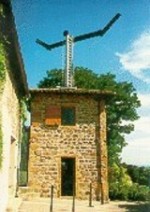 Long-distance communication at a relatively high speed (compared to carrying messages) came about with the invention of the optical telegraph in France, fifty years before the electrical telegraph.
Long-distance communication at a relatively high speed (compared to carrying messages) came about with the invention of the optical telegraph in France, fifty years before the electrical telegraph.
The optical telegraph network consisted of a chain of towers, each placed 5 to 20 kilometres apart from each other. On each of these towers a wooden semaphore and two telescopes were mounted (the telescope was invented in 1600). The semaphore had two signalling arms which each could be placed in seven positions. The wooden post itself could also be turned in 4 positions, so that 196 different positions were possible. Every one of these arrangements corresponded with a code for a letter, a number, a word or (a part of) a sentence.
1,380 kilometres an hour
Every tower had a telegrapher, looking through the telescope at the previous tower in the chain. If the semaphore on that tower was put into a certain position, the telegrapher copied that symbol on his own tower. Next he used the telescope to look at the succeeding tower in the chain, to control if the next telegrapher had copied the symbol correctly. In this way, messages were signed through symbol by symbol from tower to tower. The semaphore was operated by two levers. A telegrapher could reach a speed of 1 to 3 symbols per minute.
The technology spread through Europe, but was confounded by wars and governments. It eventually faded when the electrical telegraph came into use. Read all about this amazing but obsolete technology at Low-tech Magazine. Link -via the Presurfer
See the original post:
The Optical Telegraph




